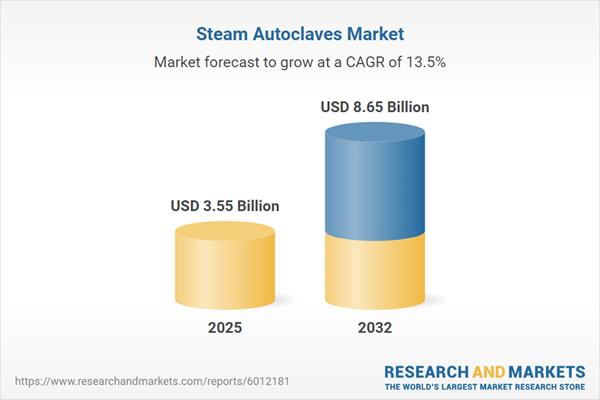Speak directly to the analyst to clarify any post sales queries you may have.
Senior decision-makers are navigating a rapidly evolving steam autoclaves market, where operational excellence, regulatory alignment, and innovation converge to define future industry growth. These systems are increasingly critical across healthcare, pharmaceuticals, research, and industrial applications as organizations seek dependable, efficient, and compliant sterilization solutions.
Market Snapshot: Growth Trajectory of the Steam Autoclaves Market
The steam autoclaves market grew from USD 3.13 billion in 2024 to USD 3.55 billion in 2025. It is expected to continue expanding at a CAGR of 13.54%, reaching USD 8.65 billion by 2032. This robust growth reflects increased demand from hospitals, pharmaceutical lines, research labs, and food processing as global regulations tighten and end-user requirements rise. Key drivers include the adoption of high-throughput, technologically advanced sterilization systems and an increased focus on compliance and operational efficiency.
Scope & Segmentation
This report offers an in-depth analysis by application, design type, capacity, sales channel, and region. Market participants benefit from a detailed breakdown exploring competitive positioning and partner opportunities.
- Type: Horizontal, Vertical
- Capacity: Large, Medium, Small
- Application: Food & Beverage, Hospitals & Clinics, Pharmaceutical, Research & Laboratories
- Sales Channel: Direct Sales, Distributors, Online
- Regional Coverage: Americas (United States, Canada, Mexico, Brazil, Argentina, Chile, Colombia, Peru), Europe (United Kingdom, Germany, France, Russia, Italy, Spain, Netherlands, Sweden, Poland, Switzerland), Middle East (United Arab Emirates, Saudi Arabia, Qatar, Turkey, Israel), Africa (South Africa, Nigeria, Egypt, Kenya), Asia-Pacific (China, India, Japan, Australia, South Korea, Indonesia, Thailand, Malaysia, Singapore, Taiwan)
- Leading Companies Analyzed: STERIS Corporation, Getinge AB, BELIMED AG, MMM Medcenter Einrichtungen GmbH, Fedegari Autoclavi S.p.A., Astell Scientific Ltd, Tuttnauer Europe Co. Ltd, Matachana S.A., Systec GmbH, Priorclave Ltd
Key Takeaways for Decision Makers
- Technological advancement is reshaping steam autoclave engineering, with modular designs, automation, and digital integration emerging as vital differentiators.
- Adoption of advanced cycle controls, proprietary software interfaces, and IoT-enabled features is streamlining maintenance and lowering operating risks.
- Sustainability imperatives are spurring the development of energy-efficient models designed to reduce water and resource consumption, aligning with global carbon reduction targets.
- Organizations optimizing supplier networks and local assembly options gain resilience against shifting regulatory and trade realities, mitigating potential supply chain disruption.
- Regional dynamics highlight diverse adoption patterns and requirements, with mature markets emphasizing safety and innovation, and emerging regions focusing on capacity building and service networks.
Tariff Impact: Navigating Policy-Driven Cost Pressures
Recent US tariffs on imported industrial equipment for 2025 have influenced supply chains and procurement strategies, prompting many companies to reevaluate vendor relationships and explore reshoring or alternative sourcing in regions such as Southeast Asia and Eastern Europe. These strategies aim to secure stable supply, minimize exposure to trade volatility, and optimize overall cost structures. Modular product architectures increasingly enable local adaptation with fewer cross-border dependencies.
Methodology & Data Sources
The analysis follows a rigorous multi-step approach, integrating secondary data from regulatory databases, technical journals, and industry reports, alongside primary insights from interviews and targeted surveys with stakeholders in key segments. Advanced modeling, including scenario analysis, ensures forecast reliability and identifies segment sensitivities amid evolving industry forces.
Why This Report Matters
- Enables precise procurement and investment decisions by mapping out technology trends, supplier strategies, and regulatory trajectories in the steam autoclaves market.
- Equips senior leaders to benchmark competitors, identify collaboration opportunities, and adapt to emerging sustainability and automation requirements.
- Supports risk mitigation through detailed coverage of trade policies, local production strategies, and supply chain diversification tactics.
Conclusion
The steam autoclaves market is advancing rapidly, shaped by innovation, sustainability, and shifting trade dynamics. Strategic investment in technology, regional adaptation, and supplier alignment will position decision-makers for continued leadership in this critical industry.
Additional Product Information:
- Purchase of this report includes 1 year online access with quarterly updates.
- This report can be updated on request. Please contact our Customer Experience team using the Ask a Question widget on our website.
Table of Contents
3. Executive Summary
4. Market Overview
7. Cumulative Impact of Artificial Intelligence 2025
Companies Mentioned
The companies profiled in this Steam Autoclaves market report include:- STERIS Corporation
- Getinge AB
- BELIMED AG
- MMM Medcenter Einrichtungen GmbH
- Fedegari Autoclavi S.p.A.
- Astell Scientific Ltd
- Tuttnauer Europe Co. Ltd
- Matachana S.A.
- Systec GmbH
- Priorclave Ltd
Table Information
| Report Attribute | Details |
|---|---|
| No. of Pages | 181 |
| Published | October 2025 |
| Forecast Period | 2025 - 2032 |
| Estimated Market Value ( USD | $ 3.55 Billion |
| Forecasted Market Value ( USD | $ 8.65 Billion |
| Compound Annual Growth Rate | 13.5% |
| Regions Covered | Global |
| No. of Companies Mentioned | 11 |









